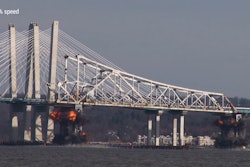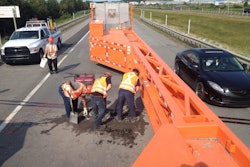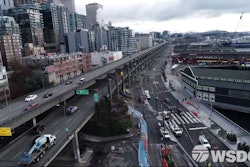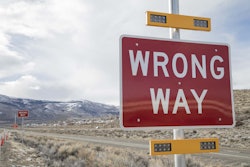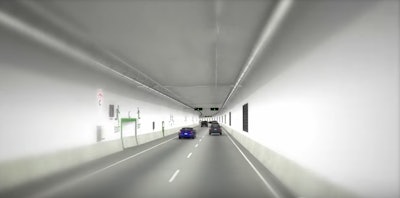
With the closure this week of State Route 99 in Seattle for tunnel work, construction crews are on schedule with good weather, including unusually warm daytime temperatures in Puget Sound.
So that crews could realign SR 99 to a new tunnel, the Alaskan Way Viaduct was shut down from South Spokane Street to the south end of the Battery Street Tunnel, according to the Washington State Department of Transportation (WSDOT).
The SR 99 Alaskan Way Viaduct – an elevated concrete structure built in the 1950s – is being replaced with the 1.7-mile tunnel running beneath downtown Seattle.
Replacing the viaduct with a tunnel allows the highway to remain open for much of construction, minimizing closures and impacts to traffic. Once the tunnel opens, the viaduct will be taken down to clear the way for new public space along Seattle’s downtown waterfront.
Contractor Scarsella Brothers, a family-owned heavy civil construction company based in Seattle, began construction on this phase Jan. 11 with three shifts going to work at both ends of the tunnel, trying to keep the closure short and open the new tunnel as quickly as possible,
“Overall, work is proceeding as planned,” according to Laura Newborn, spokesperson for the viaduct replacement program, reports King 5 TV of Seattle.
In just a few days, the two detours that connected the Alaskan Way Viaduct to the southern part of SR 99 were erased by the new construction. Crews have excavated two ramps built and buried in 2014 in preparation for the final connection to the new tunnel, the station reports.
This is one of the final pieces of work involved in opening the new SR 99 tunnel – connecting the tunnel to SR 99 at both ends, says WSDOT. The SR 99 Connections Project encompasses this work.
Contractor Scarsella Bros. is completing the ramp and road connections between the new tunnel and SR 99, the department says. Most of the work will take place in the existing construction areas for the SR 99 tunnel. There will also be some sign bridge work on SR 99 and surface street paving.
The new tunnel changes the way drivers get around in Seattle:
Drivers approaching the tunnel from either direction will face a choice depending on their destination: use the tunnel to bypass downtown or exit to city streets and head into downtown.
At the tunnel’s north end, downtown access will entail on- and off-ramps near Seattle Center. From the south, new on- and off-ramps will connect SR 99 to downtown via the new waterfront street.
For the latest construction notifications, visit the Notices and detours page.
Tunneling machine Bertha
The tunneling machine known as Bertha began tunneling beneath Seattle in July 2013. After falling nearly three years behind schedule due to several delays and mechanical issues with the tunneling machine, Bertha completed the its tunneling on April 4, 2017 and was fully dismantled and removed from the tunnel on August 23, 2017.
Now, more than half of the viaduct has been replaced by crews at the south end of downtown, near Seattle’s stadiums, according to the Washington Department of Transportation (WSDOT).
The SR 99 Tunnel Project is estimated to cost $3.3 billion.
The cost includes Seattle Tunnel Partners’ contract with WSDOT as well as the other projects that will connect the SR 99 tunnel with a mile-long stretch of new highway near Seattle’s stadiums at the south end of the tunnel and Aurora Avenue North at the north end of the tunnel, the agency says. New ramps and connections to city streets are being built.
Details from WSDOT on the new tunnel:
- Opens early 2019
- Two miles long
- Two lanes in each direction, plus an eight-foot safety shoulder
- South portal near stadiums; north portal near Space Needle
- No mid-tunnel exits or entrances
- Will open toll-free for a period of time; tolling starts on a date to be determined
Contractor Seattle Tunnel Partners (STP) bored the tunnel and built the highway within it. The contract also includes also constructing buildings at each tunnel portal to house lighting, ventilation and other systems needed to operate the tunnel.
This new section of SR 99 connects to the remaining viaduct along the waterfront to keep SR 99 traffic moving until the tunnel opens to traffic.
The Alaskan Way Viaduct Replacement Program includes projects led by the Washington State Department of Transportation, King County, the City of Seattle and the Port of Seattle. The Federal Highway Administration is a partner.
Major elements of the six-year project:
- The nearly two-mile-long tunnel beneath downtown Seattle
- A mile-long stretch of new highway that connects to the south entrance of the tunnel, near Seattle’s stadiums.
- A new overpass at the south end of downtown that allows traffic to bypass train blockages near Seattle’s busiest port terminal.
- Demolition of the viaduct’s downtown waterfront section.
- A new Alaskan Way surface street along the waterfront that connects SR 99 to downtown.




